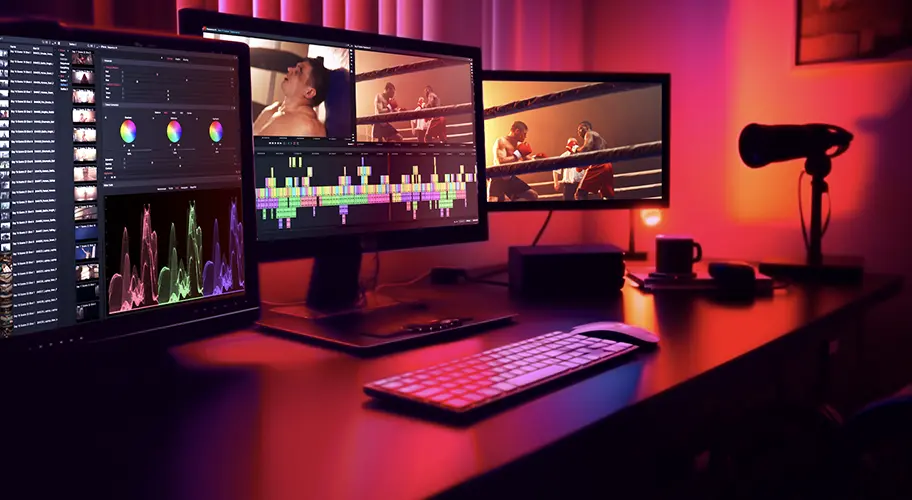In today's digital age, video content reigns supreme across various platforms, from social media to professional presentations. With the increasing demand for high-quality videos, there's also a growing interest in video editing courses, especially in places like Pakistan, where the digital landscape is rapidly evolving. If you're considering delving into the realm of video editing course in Pakistan, it's essential to grasp the fundamentals of video formats and resolutions. Understanding these concepts lays the groundwork for producing captivating and professional-grade videos.
What Are Video Formats?
Video formats refer to the way digital video files are encoded and compressed. Each format comes with its own specifications, affecting factors such as file size, quality, and compatibility across different devices and platforms. Common video formats include MP4, AVI, MOV, WMV, and more.
MP4 (MPEG-4):
MP4 stands as one of the most widely used video formats, renowned for its balance between quality and file size. It employs efficient compression algorithms, making it ideal for online streaming, social media uploads, and mobile device playback.
AVI (Audio Video Interleave):
AVI is a popular video format developed by Microsoft. While it offers excellent video quality, its drawback lies in larger file sizes compared to more modern formats like MP4. However, it remains a preferred choice for storing raw footage or editing projects due to its uncompressed nature.
MOV (QuickTime Movie):
Developed by Apple, MOV is prevalent among Mac users and is compatible with both Mac and Windows platforms. It supports high-quality video and audio, making it suitable for professional editing projects and playback on various devices.
Understanding Video Resolutions
Video resolution determines the clarity and detail of an image displayed on screen, typically measured in pixels (width x height). Higher resolutions offer sharper images but also result in larger file sizes. Common resolutions include SD (Standard Definition), HD (High Definition), Full HD, and Ultra HD (4K).
SD (Standard Definition):
SD resolution typically refers to 480p, with a resolution of 640x480 pixels. While it was once the standard for television broadcasts, it's gradually being phased out in favor of higher resolutions due to advancements in technology and display capabilities.
HD (High Definition):
HD resolutions, such as 720p (1280x720 pixels) and 1080p (1920x1080 pixels), offer significantly improved clarity and detail compared to SD. They are widely used for online streaming, Blu-ray discs, and television broadcasts, providing a crisp viewing experience for audiences.
Full HD and Ultra HD (4K):
Full HD (1080p) represents the pinnacle of HD resolution, offering stunning clarity and detail. On the other hand, Ultra HD (4K) takes it a step further with a resolution of 3840x2160 pixels, delivering unparalleled visual fidelity. While 4K content requires substantial storage and processing power, it's becoming increasingly popular for professional productions and high-end displays.
Importance of Choosing the Right Format and Resolution
Selecting the appropriate video format and resolution is crucial for achieving the desired outcome in your editing projects. Factors to consider include the intended use of the video, target audience, platform requirements, and available resources.
For instance, if you're creating content for social media platforms like Facebook or Instagram, you'll want to prioritize formats like MP4 and resolutions optimized for mobile viewing. On the other hand, if you're working on a cinematic project destined for the big screen, higher resolutions such as 4K may be necessary to ensure an immersive viewing experience.
In the context of Pakistan, where access to high-speed internet and advanced technology may vary across regions, it's essential to strike a balance between video quality and file size. This ensures that your content remains accessible and engaging to a diverse audience.
Video Editing Courses in Pakistan: Empowering Aspiring Editors
As interest in video editing continues to soar in Pakistan, there's a growing demand for comprehensive training programs tailored to the needs of aspiring editors. Institutions and online platforms offering video editing courses play a pivotal role in equipping students with the knowledge and skills necessary to thrive in this dynamic field.
Understanding Video Editing Course Fees
When considering enrolling in a video editing course, it's natural to factor in the associated fees. The cost of such courses can vary depending on factors such as the duration of the program, the level of expertise offered, and the reputation of the institution or instructor.
In Pakistan, video editing course fee are offered by a range of educational institutions, from traditional universities to specialized training centers and online platforms. The fees for these courses can range from affordable options for beginners to more comprehensive and costly programs for those seeking advanced training and certification.
Conclusion
In conclusion, mastering video formats and resolutions is essential for anyone embarking on a journey into the world of video editing, particularly in places like Pakistan where the demand for skilled professionals is on the rise. By understanding the nuances of different formats and resolutions, aspiring editors can create compelling and visually stunning content that resonates with audiences across various platforms.
Moreover, enrolling in a reputable video editing course provides invaluable guidance and hands-on experience, empowering individuals to hone their skills and pursue rewarding careers in the field. While considering factors such as course fees, it's essential to prioritize quality education that equips you with the tools and knowledge needed to succeed in the competitive landscape of video editing. With dedication, creativity, and a solid understanding of video formats and resolutions, the possibilities for aspiring editors in Pakistan are limitless.


No comments yet